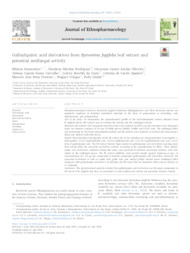Galloylquinic acid derivatives from Byrsonima fagifolia leaf extract and potential antifungal activity.
Galloylquinic acid derivatives from Byrsonima fagifolia leaf extract and potential antifungal activity.
Author(s): SANNOMIYA, M.; RODRIGUES, C. M.; OLIVEIRA, G. C. A.; CARVALHO, J. C. S.; COSTA, L. S. DA; SPADARI, C. DE C.; FERREIRA, M. J. P.; VILEGAS, W.; ISHIDA, K.
Summary: Ethnopharmacological relevance: Byrsonima fagifolia Niedenzu (Malpighiaceae) and other Byrsonima species are popularly employed in Brazilian traditional medicine in the form of preparations as cicatrizing, antiinflammatory, and antimicrobial. Aim of the study: To characterize the phytochemical profile of the hydromethanolic extract obtained from B. fagifolia leaves (BF extract) and to evaluate the toxicity and the antifungal activity. based on extensive analyses of 1D and 2D NMR spectra (HMQC, HMBC and COSY) data. The antifungal effect was determined by the broth microdilution method and the toxicity was evaluated on erythrocytes from sheep?s blood and Galleria mellonella larvae. Results: Phytochemical investigation of the BF extract led to the isolation and characterization of pyrogallol, nbutyl gallate, 3,4-di-O-galloylquinic acid, 3,5-di-O-galloylquinic acid, 3,4,5-tri-O-galloylquinic acid, and 1,3,4,5-tetra-O-galloylquinic acid. The BF extract showed high content of galloylquinic acid derivatives reaching more than twenty-times the quercetin derivatives content, according to the quantification by HPLC. These galloylquinic acid derivatives, obtained during this study, and quercetin derivatives, previously isolated, were submitted to the antifungal assays. The BF extract inhibited yeast growth mainly against Cryptococcus spp., at concentrations of 1?16 ?g/mL, comparable to isolated compounds galloylquinic acid derivatives. However, the quercetin derivatives as well as quinic acid, gallic acid, and methyl gallate showed lower antifungal effect compared with galloylquinic derivatives. In addition, the BF extract had no hemolytic effect and no toxicity on G. mellonella.
Publication year: 2022
Types of publication: Journal article
Unit: Embrapa Agroenergy
Observation
Some of Embrapa's publications are published as ePub files. To read them, use or download one of the following free software options to your computer or mobile device. Android: Google Play Books; IOS: iBooks; Windows and Linux: Calibre.
Access other publications
Access the Agricultural Research Database (BDPA) to consult Embrapa's full library collection and records.
Visit Embrapa Bookstore to purchase books and other publications sold by Embrapa.

